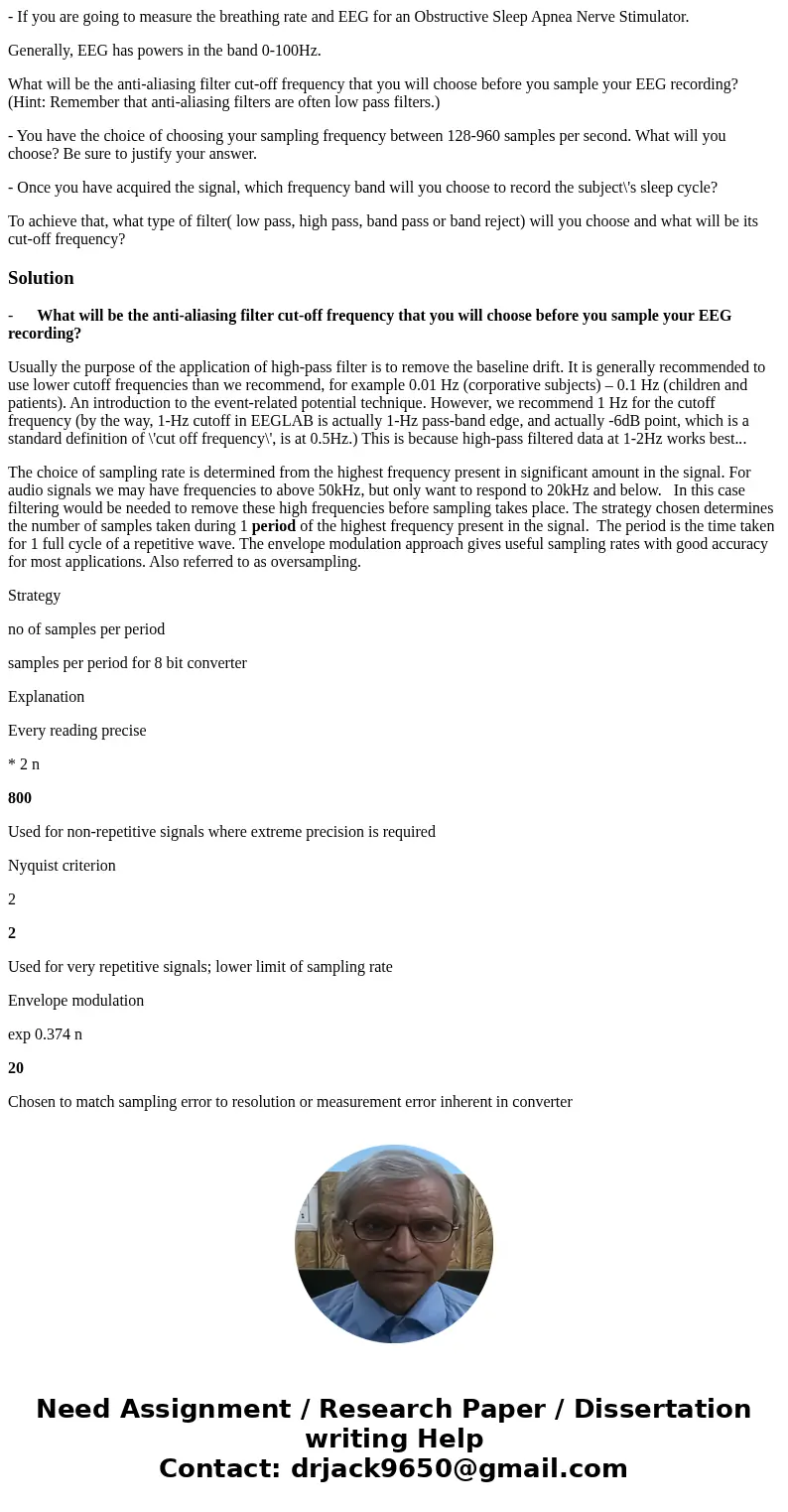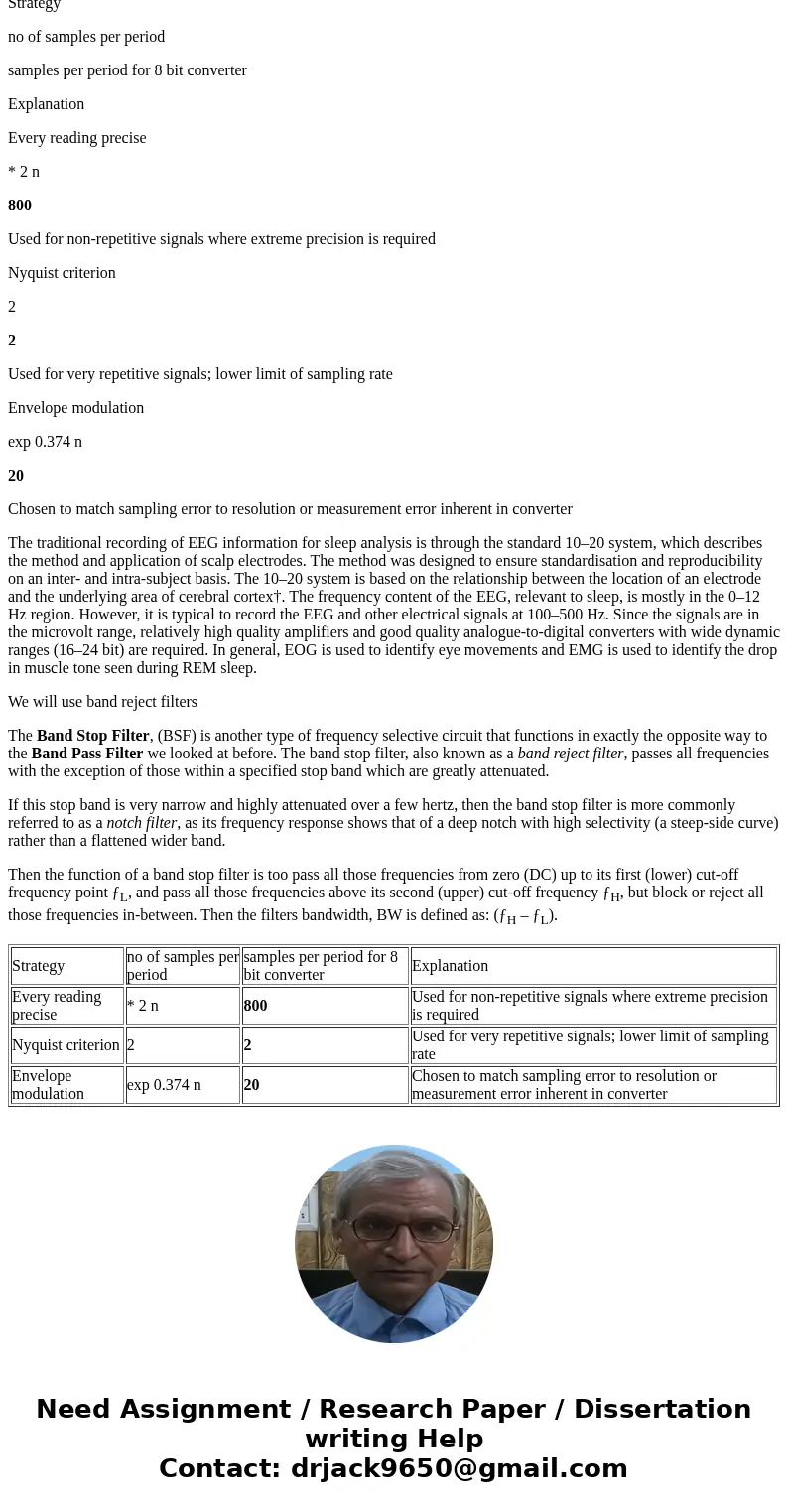If you are going to measure the breathing rate and EEG for
- If you are going to measure the breathing rate and EEG for an Obstructive Sleep Apnea Nerve Stimulator.
Generally, EEG has powers in the band 0-100Hz.
What will be the anti-aliasing filter cut-off frequency that you will choose before you sample your EEG recording? (Hint: Remember that anti-aliasing filters are often low pass filters.)
- You have the choice of choosing your sampling frequency between 128-960 samples per second. What will you choose? Be sure to justify your answer.
- Once you have acquired the signal, which frequency band will you choose to record the subject\'s sleep cycle?
To achieve that, what type of filter( low pass, high pass, band pass or band reject) will you choose and what will be its cut-off frequency?
Solution
- What will be the anti-aliasing filter cut-off frequency that you will choose before you sample your EEG recording?
Usually the purpose of the application of high-pass filter is to remove the baseline drift. It is generally recommended to use lower cutoff frequencies than we recommend, for example 0.01 Hz (corporative subjects) – 0.1 Hz (children and patients). An introduction to the event-related potential technique. However, we recommend 1 Hz for the cutoff frequency (by the way, 1-Hz cutoff in EEGLAB is actually 1-Hz pass-band edge, and actually -6dB point, which is a standard definition of \'cut off frequency\', is at 0.5Hz.) This is because high-pass filtered data at 1-2Hz works best...
The choice of sampling rate is determined from the highest frequency present in significant amount in the signal. For audio signals we may have frequencies to above 50kHz, but only want to respond to 20kHz and below. In this case filtering would be needed to remove these high frequencies before sampling takes place. The strategy chosen determines the number of samples taken during 1 period of the highest frequency present in the signal. The period is the time taken for 1 full cycle of a repetitive wave. The envelope modulation approach gives useful sampling rates with good accuracy for most applications. Also referred to as oversampling.
Strategy
no of samples per period
samples per period for 8 bit converter
Explanation
Every reading precise
* 2 n
800
Used for non-repetitive signals where extreme precision is required
Nyquist criterion
2
2
Used for very repetitive signals; lower limit of sampling rate
Envelope modulation
exp 0.374 n
20
Chosen to match sampling error to resolution or measurement error inherent in converter
The traditional recording of EEG information for sleep analysis is through the standard 10–20 system, which describes the method and application of scalp electrodes. The method was designed to ensure standardisation and reproducibility on an inter- and intra-subject basis. The 10–20 system is based on the relationship between the location of an electrode and the underlying area of cerebral cortex†. The frequency content of the EEG, relevant to sleep, is mostly in the 0–12 Hz region. However, it is typical to record the EEG and other electrical signals at 100–500 Hz. Since the signals are in the microvolt range, relatively high quality amplifiers and good quality analogue-to-digital converters with wide dynamic ranges (16–24 bit) are required. In general, EOG is used to identify eye movements and EMG is used to identify the drop in muscle tone seen during REM sleep.
We will use band reject filters
The Band Stop Filter, (BSF) is another type of frequency selective circuit that functions in exactly the opposite way to the Band Pass Filter we looked at before. The band stop filter, also known as a band reject filter, passes all frequencies with the exception of those within a specified stop band which are greatly attenuated.
If this stop band is very narrow and highly attenuated over a few hertz, then the band stop filter is more commonly referred to as a notch filter, as its frequency response shows that of a deep notch with high selectivity (a steep-side curve) rather than a flattened wider band.
Then the function of a band stop filter is too pass all those frequencies from zero (DC) up to its first (lower) cut-off frequency point ƒL, and pass all those frequencies above its second (upper) cut-off frequency ƒH, but block or reject all those frequencies in-between. Then the filters bandwidth, BW is defined as: (ƒH – ƒL).
| Strategy | no of samples per period | samples per period for 8 bit converter | Explanation |
| Every reading precise | * 2 n | 800 | Used for non-repetitive signals where extreme precision is required |
| Nyquist criterion | 2 | 2 | Used for very repetitive signals; lower limit of sampling rate |
| Envelope modulation | exp 0.374 n | 20 | Chosen to match sampling error to resolution or measurement error inherent in converter |


 Homework Sourse
Homework Sourse